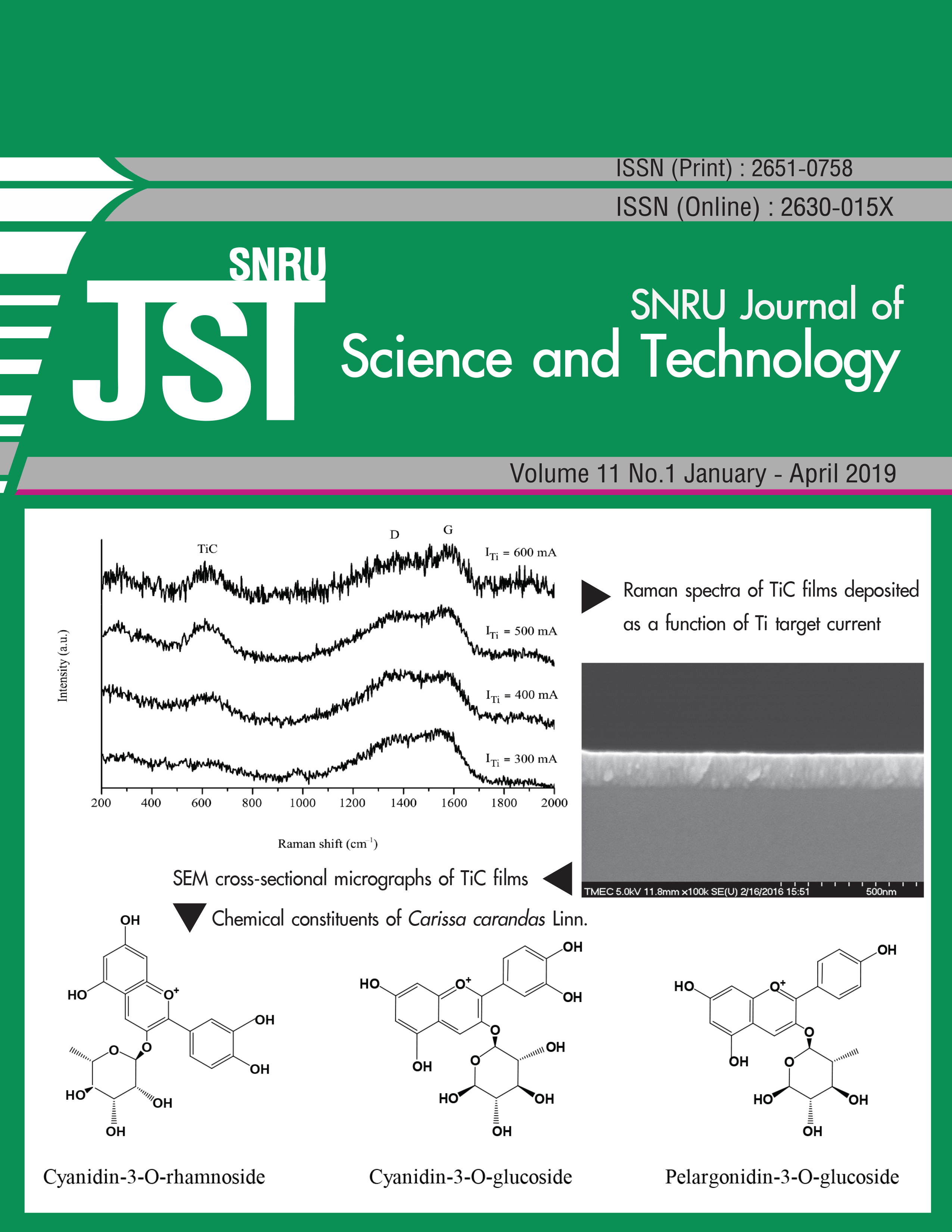Antioxidants activity and exhibit to stimulate immune cell production in in vitro of Hibiscus sabdariffa Linn. and Phyllanthus emblica L. extracts
Keywords:
Hibiscus sabdariffa Linn., Phyllanthus emblica L., Antioxidant, Anti-inflammation, Immune cell stimulation, Methanolic extractAbstract
Hibiscus sabdariffa Linn. and Phyllanthus emblica L. are widely used in traditional Thai medicine as natural remedies. The aim of this study was to investigate the total phenolics and flavonoids contents, antioxidant activities, NO inhibition and cytotoxicities of methanolic extracts. The result showed that H. sabdariffa Linn. and P. emblica L. extracts contain high amount of total phenolics and flavonoids contents which were related to the antioxidant activities. P. emblica L. extract showed to inhibit NO production in dose dependent manner. In addition, both extracts showed to stimulate the number of mouse macrophage cell line in the in vitro. These data suggest that H. sabdariffa Linn. and P. emblica L. extracts may be potentially beneficial in the treatment of inflammatory diseases through the inhibition of NO production as well as stimulation of immune system via increasing number of immunize cells.
References
[2] C. Murr, B.M. Winklhofer-Roob, K. Schroecksnadel, M. Maritschnegg, H. Mangge, B.O. Böhm, Inverse association between serum concentrations of neopterin and antioxidants in patients with and without angiographic coronary artery disease, Atherosclerosis. 202(2) (2009) 543 – 549.
[3] D. Fuchs, P. Avanzas, R. Arroyo-Espliguero, M. Jenny, L. Consuegra-Sanchez, J.C. Kaski, The role of neopterin in atherogenesis and cardiovascular risk assessment, Curr Med Chem. 16(35) (2009) 46 – 53.
[4] E. Ginter, V. Simko, V. Panakova, Antioxidants in health and disease, Bratisl Lek Listy. (115) (2004) 603 – 606.
[5] K. Apel, H. Hirt, Reactive oxygen species: Metabolism, oxidative stress, and signal transduction, Annu Rev Plant Biol. (55) (2004) 373 – 399.
[6] J.M. McCord, The evolution of free radicals and oxidative stress, Am J Med. 108(8) (2000) 652 –659.
[7] B. Saad, O. Said, Greco-Arab and Islamic Herbal Medicine: Traditional System, Ethics, Safety, Efficacy and Regulatory Issues, Wiley-Blackwell John Wiley & Sons Inc, New Jersey, 2011.
[8] B. Saad, Integrating traditional Greco-Arab and Islamic diet and herbal medicines in research and clinical practice, in: I. Ramzan (Eds.), Phytotherapies: Efficacy, safety and regulation, Wiley-Blackwell John Wiley & Sons, Inc., New Jersey, 2015, pp. 142 – 148.
[9] H. Zaid, B. Saad, State of the Art of Diabetes Treatment in Greco-Arab and Islamic Medicine. In: R.R. Watson, V.R. Preedy (Eds.), Bioactive Food as Dietary Interventions for Diabetes, Academic Press, San Diego, 2013, pp. 327 – 337.
[10] N. Chahmi, J. Anissi, S. Jennan, A. Farah, K. Sendide, M.E. Hassouni, Antioxidant activities and total phenol content of Inula viscosa extracts selected from three regions of Morocco, Asian Pac J Trop Biomed. 5(3) (2015) 228 – 233.
[11] N. Tlili, H. Mejri, F. Anouer, E. Saadaoui, A. Khaldi, N. Nasri, Phenolic profile and antioxidant activity of Capparis spinosa seeds harvested from different wild habitats, Ind Crops Prod. 76 (2015) 930 – 935.
[12] M. Zheng, Q. Xia, S. Lu, Study on drying methods and their influences on effective components of loquat flower tea, LWT – Food Sci. Technol. 63 (2015) 14 – 20.
[13] D. Jang, G.A. Murrell, Nitric oxide in arthritis, Free Radic Biol Med. 24(9) (1998) 1511 – 1519.
[14] N.W. Kooy, S.J. Lewis, J.A. Royall, Y.Z. Ye, D.R. Kelly, J.S. Beckman, Extensive tyrosine nitration in human myocardial inflammation: evidence for the presence of peroxynitrite, Crit Care Med. 25(5) (1997) 812 – 819.
[15] E. Iwashita, T. Miyahara, K. Hino, T. Tokunaga, H. Wakisaka, Y. Sawazaki, High nitric oxide synthase activity in endothelial cells in ulcerative colitis, J Gastroenterol. 30(4) (1995) 551 – 554.
[16] C.M. Hogaboam, K. Jacobson, S.M. Collins, M.G. Blennerhassett, The selective beneficial effects of nitric oxide inhibition in experimental colitis, Am J Physiol Gastrointest Liver Physiol. 268(4) (1995) 673 – 684.
[17] C.J. Kelly, D.P. Gold, Nitric oxide in interstitial nephritis and other autoimmune diseases, Semin Nephrol. 19(3) (1999) 288 – 295.









